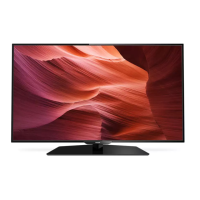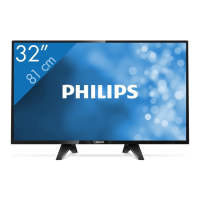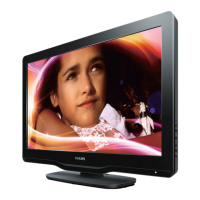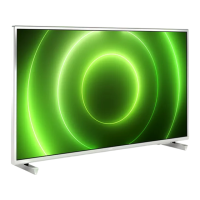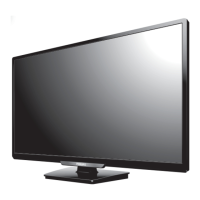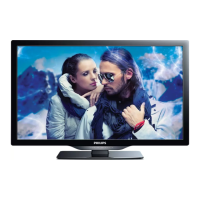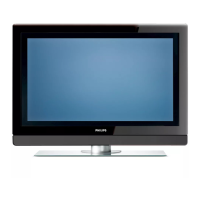How to remove black bars on Philips 32PF5331/10 in PC mode?
- AAlexandria PrattSep 12, 2025
If your Philips TV is displaying a black bar on the top and bottom of the screen in PC mode, change the PC refresh rate to 60 Hz.
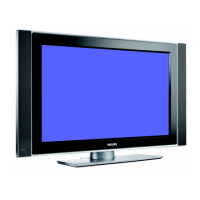
How to remove black bars on Philips 32PF5331/10 in PC mode?
If your Philips TV is displaying a black bar on the top and bottom of the screen in PC mode, change the PC refresh rate to 60 Hz.
Why is PC mode not working on my Philips 32PF5331/10?
If PC modes are not working on your Philips TV, check whether the connections are correct. Verify that you've selected the correct source. Ensure that you have configured the computer on a compatible display resolution and check the graphic card setting of your PC.
| Screen Size | 32 inches |
|---|---|
| Display diagonal | 81 cm |
| Resolution | 1366 x 768 pixels |
| Display Technology | LCD |
| Response time | 8 ms |
| Contrast ratio (typical) | 800:1 |
| Display brightness | 500 cd/m² |
| Comb filter | 3D |
| Audio system | Nicam Stereo |
| Number of speakers | 2 |
| Plug and Play | Yes |
| SCART ports quantity | 2 |
| HDMI ports quantity | 1 |
| Component video (YPbPr/YCbCr) in | 1 |
| PC in (D-Sub) | Yes |
| Weight (with stand) | 15 kg |
| Power consumption (standby) | 0.5 W |
| USB Ports | No |
| Aspect Ratio | 16:9 |
| Screen format adjustments | 16:9 |
| Viewing angle, horizontal | 176 degrees |
| Viewing angle, vertical | 176 degrees |
| Tuner type | Analog |
| Width (with stand) | 800 mm |
| Width (without stand) | 800 mm |
| Depth (without stand) | 9.5 cm |
| Refresh Rate | 50 Hz |
| Weight | 12 kg |
Instructions for correctly disposing of old electronic products to protect the environment and human health.
Ensuring proper ventilation and safe placement to prevent overheating and hazards.
Guidelines for safe electrical connections, power cord handling, and fire prevention.
Protecting the TV from moisture, heat, flames, lightning, and water spills.
Ensuring safe installation, especially for wall-mounting, by qualified personnel.
Guidelines for placing the TV set on a stable surface with adequate ventilation.
Instructions for connecting the aerial and mains plug to the TV set.
How to prepare and use the remote control for TV operation.
Steps to power on the TV set from standby mode or initial setup.
Details on POWER, VOLUME, MENU, and PROGRAM/CHANNEL buttons on the TV set itself.
Description of rear panel ports including Aerial, DVI, Component, HDMI, and Scart inputs/outputs.
Explanation of side panel ports for connecting cameras, camcorders, and headphones.
Controls for TV standby, volume adjustment, program selection, and mute function.
Keys for accessing menus, navigating options, and confirming selections on screen.
Buttons for adjusting picture/sound settings and accessing features like PIP and Screen Format.
Keys for selecting input modes (DVD, AUX, AV) and accessing Teletext functions.
Steps for automatic channel search and storage using the Plug'n'Play feature.
Instructions for manually sorting TV channels and re-numbering them.
Procedure for automatic searching and storing of available TV channels.
Explanation of picture settings like Brightness, Colour, Contrast, Sharpness, and Colour Temp.
Explanation of sound settings like Equalizer, Balance, Delta Volume, AVL, and Dolby Virtual.
How to access and configure Picture-in-Picture using the TV's menu system.
Displaying and cycling through PIP screen sizes using the remote control.
Explains 4:3, 14:9, and 16:9 picture formats and their display characteristics.
Details on Subtitle Zoom and Superzoom modes for displaying 4:3 pictures.
How to display 16:9 images correctly or enlarge 4:3 horizontally.
Turning teletext on/off and selecting pages using number keys or color keys.
Navigating teletext, sub-pages, hidden info, and setting favourite pages.
Steps to connect a PC via HDMI and select it as a source for display.
Using Picture-in-Picture to watch TV while operating in PC mode.
Adjusting picture and audio settings when using the TV as a PC monitor.
Connecting HD equipment via HDMI and selecting it as a source for viewing.
Details on HD features like Timer, PIP, Horizontal Shift, and Mode Selection.
Guide to identifying and resolving common TV problems such as no picture, no sound, or poor reception.
Key specifications including screen size, audio output, power, and dimensions for different models.
Table listing country abbreviations for channel tuning and selection.
Guidelines for optimal TV positioning and ensuring adequate ventilation for operation.
Information on improving TV reception and addressing signal interference issues.
Instructions for safe mains power connection and aerial cable attachment.
Guidance on correctly attaching the TV stand for stability.

